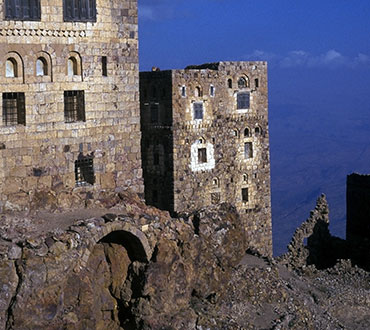Professor Marchand’s talk was in three sections: an overview of the recent tragic occurrences in Yemen; a brief survey of the diversity of Yemen’s architecture; and the main core of his presentation, his personal research undertaken whilst working as an apprentice to minaret builders in Sana’a during 1996-97. This part of his presentation included the fascinating study of the transmission of knowledge from teacher to apprentice – the way builders work and learn on site – and in so doing, develop their own identities as professionals and tradespeople.
Briefly touching on the economic histories of the various Yemeni regions, towns and cities, Trevor discussed how the different trade practices brought from other countries via the trade routes changed both tastes and technologies. He explained that Yemen has been a site of regional conflict and insecurity for many centuries, and how this lack of security has had a major impact on architectural styles, resulting in houses in outlying areas often being built in a defensive fashion with enclosure walls and circular towers. Gender relations, as well as religious and economic status, have also had a major impact on the architectural style of family dwellings. Other influential factors include the natural materials that are available to each region, the properties of those materials, whether the region was an earthquake zone or not, and the climate and topography of the landscape.
In the past, as Trevor explained, Yemeni males who wanted to become builders migrated to the larger towns and cities so that they could become labourers and eventually apprentices to a master mason. As there is no guild structure in Sana’a, masons and builders visited each other at their different sites, exchanging knowledge and ideas, as well as sharing apprentices.
After having traced the building of the minaret from the foundations of the structure through to the tower and dome for the audience, Trevor talked about what he believes is the most important part of heritage. It is not only the preservation of the buildings themselves, but also the preservation of the process of human knowledge which in turn has reproduced the changing architectural landscape of Yemen’s diverse regions.
The lecture may be viewed here:


